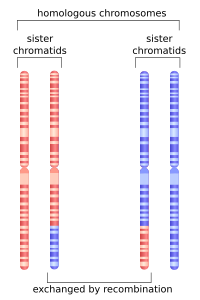
Photo from wikipedia
Simple Summary High-grade serous ovarian cancer (HGSOC) is the most frequent and lethal form of ovarian cancer and is associated with homologous recombination deficiency (HRD) in 50% of cases. This… Click to show full abstract
Simple Summary High-grade serous ovarian cancer (HGSOC) is the most frequent and lethal form of ovarian cancer and is associated with homologous recombination deficiency (HRD) in 50% of cases. This specific alteration is associated with sensitivity to PARP inhibitors (PARPis). Despite vast prognostic improvements due to PARPis, current molecular assays assessing HRD status suffer from several limitations, and there is an urgent need for a more accurate evaluation. In these companion reviews (Part 1: Technical considerations; Part 2: Medical perspectives), we develop an integrative review to provide physicians and researchers involved in HGSOC management with a holistic perspective, from translational research to clinical applications. Abstract High-grade serous ovarian cancer (HGSOC), the most frequent and lethal form of ovarian cancer, exhibits homologous recombination deficiency (HRD) in 50% of cases. In addition to mutations in BRCA1 and BRCA2, which are the best known thus far, defects can also be caused by diverse alterations to homologous recombination-related genes or epigenetic patterns. HRD leads to genomic instability (genomic scars) and is associated with PARP inhibitor (PARPi) sensitivity. HRD is currently assessed through BRCA1/2 analysis, which produces a genomic instability score (GIS). However, despite substantial clinical achievements, FDA-approved companion diagnostics (CDx) based on GISs have important limitations. Indeed, despite the use of GIS in clinical practice, the relevance of such assays remains controversial. Although international guidelines include companion diagnostics as part of HGSOC frontline management, they also underscore the need for more powerful and alternative approaches for assessing patient eligibility to PARP inhibitors. In these companion reviews, we review and present evidence to date regarding HRD definitions, achievements and limitations in HGSOC. Part 1 is dedicated to technical considerations and proposed perspectives that could lead to a more comprehensive and dynamic assessment of HR, while Part 2 provides a more integrated approach for clinicians.
Journal Title: Cancers
Year Published: 2022
Link to full text (if available)
Share on Social Media: Sign Up to like & get
recommendations!